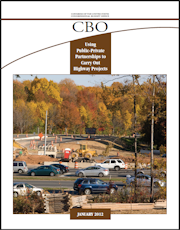Public-private partnerships have advantages and disadvantages as a strategy for building and maintaining the nation’s roads and highways, concludes a recently published Congressional Budget Office (CBO) report, “Using Public-Private Partnerships to Carry Out Highway Projects.”
The CBO found tentatively that partnerships have built highways “slightly less expensively and slightly more quickly” compared to the traditional public-sector approach. The speed-up in construction time is most evident in larger projects valued at $100 million or more. But the number of studies supporting that conclusion is relatively small and results regarding one project are difficult to apply to others.
Another finding is that private-sector management also can bring about a reduction in operational costs, although firm conclusions are clouded in the two studies cited by the impact of the recession and associated reduction in traffic. Private-sector managers might choose more effective procedures and schedules for maintenance, the study suggested. “In many cases, smaller, more regular repairs are a more cost-effective approach to road maintenance than are larger, irregular repairs, but they may be less common when a road is under public control because of states’ and localities’ budgeting practices.”
Public-private partnerships (P3s) offer pros and cons in financing. Public entities can tap tax-free municipal bonds; private-sector investors can use depreciation to lower their tax exposure. But private financing come with the expectation of a future return, the ultimate source of which is either taxes or tolls. The primary advantage of private financing is that it makes funds available in states or localities that “have chosen to restrict their spending by imposing legal constraints or budgetary limits on themselves.”
One other important attribute of P3s, notes the study, is the opportunity to contractually define and allocate risk. Under the traditional approach to road building, government assumes most of the risk associated with cost overruns, construction delays and, in the case of toll projects, shortfalls in toll revenues. In P3s, the private-sector partner generally assumes the risk for cost overruns and construction delays. But, after toll revenues in early projects fall short of projections, private partners have been seeking revenue guarantees from the public partner.
A drawback of P3s, says the study, is the loss of public control. Contracts typically turn toll-setting authority over to the private partner. Higher tolls are the likely result, “an outcome that may conflict with other public-sector goals.”
The study provides a useful discussion of P3 pros and cons, but it overlooks a number of important considerations.
An advantage of P3s is that projects tend to be more transparent. More information about a road project’s costs, revenues and risks are made public. The public partner can monitor performance and financial metrics and hold the private partner more accountable than it could hold its own bureaucracy.
On the other hand, P3s reduce the opportunity for meaningful public input. Much of the negotiation between government and the private sector necessarily takes place behind closed doors. Once terms and conditions are reached, it is exceedingly difficult to renegotiate them if the public doesn’t like them. The result is typically a fait accompli.



